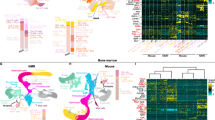Abstract
A role for proto-oncogenes in the regulation and modulation of cell proliferation1,2 has been suggested by the findings that the B-chain of platelet-derived growth factor (PDGF) is encoded by the proto-oncogene sis3–7 and that the erb-B oncogene product is a truncated form of the epidermal growth factor (EGF) receptor8–10. Furthermore, the product of the proto-oncogene fms (c-fms) may be related or identical to the receptor for macrophage colony-stimulating factor (CSF-1)11. v-fms is the transforming gene of the McDonough strain of feline sarcoma virus (SM-FeSV)12,13 and belongs to the family of src-related oncogenes which have tyrosine-specific kinase activity. Furthermore, nucleo-tide sequence analysis of the v-fms gene product revealed topologi-cal properties of a cell-surface receptor protein14. To elucidate the features involved in the conversion of a normal cell-surface receptor gene into an oncogenic one, we have now determined the complete nucleotide sequence of a human c-fms complementary DNA. The 972-amino-acid c-fms protein has an extracellular domain, a membrane-spanning region, and a cytoplasmic tyrosine protein kinase domain. Comparison of the feline v-fms and human c-fms sequences reveals that the proteins share extensive homology but have different carboxyl termini.
This is a preview of subscription content, access via your institution
Access options
Subscribe to this journal
Receive 51 print issues and online access
$199.00 per year
only $3.90 per issue
Buy this article
- Purchase on Springer Link
- Instant access to full article PDF
Prices may be subject to local taxes which are calculated during checkout
Similar content being viewed by others
References
Bishop, J. M. Cell 42, 23–28 (1985).
Muller, R. & Verma, I. M. Curr. Topics Microbiol. Immun. 112, 73–115 (1984).
Doolittle, R. F. et al. Science 221, 275–277 (1983).
Waterfield, M. D. et al. Nature 304, 35–39 (1983).
Devare, S. G., Reddy, E. P., Law, J. D., Robbins, K. C. & Aaronson, S. A. Proc. natn. Acad. Sci. U.S.A. 80, 731–735 (1983).
Hunter, T. Trends biochem. Sci. 10, 275–280 (1985).
Van Beveren, C. & Verma, I. M. Curr. Topics Microbiol. Immun. 123, 73–98 (1985).
Ullrich, A. et al. Nature 309, 418–425 (1984).
Xu, Y.-H. et al. Nature 309, 806–810 (1984).
Lin, C. R. et al. Science 224, 843–848 (1984).
Sherr, C. J. et al. Cell 41, 665–676 (1985).
Donner, L., Fedele, L. A., Garon, C. F., Anderson, S. J. & Sherr, C. J. J Virol. 41, 489–500 (1982).
Heisterkamp. N. et al. Virology 126, 248–258 (1983).
Hampe, A., Gobet, M., Sherr, C. J. & Galibert, F. Proc. natn. Acad. Sci. U.S.A. 81, 85–89 (1984).
Kozak, M. Microbiol. Rev. 47, 1–45 (1983).
Wickner, W. T. & Lodish, H. F. Science 230, 400–407 (1985).
Rettenmier, C. W. et al. Science 228, 320–322 (1985).
Pfeffer, S. & Ullrich, A. Nature 313, 184 (1985).
Ullrich, A. et al. Nature 313, 756–761 (1985).
Yamamoto, T. et al. Cell 39, 27–38 (1984).
Morgan, C. J. & Stanley, E. R. Biochem. biophys. Res. Commun. 119, 35–41 (1984).
Neckameyer, W. S. & Wang, L.-H. J Virol. 53, 879–884 (1985).
Downward, J., Parker, P. & Waterfield, M. D. Nature 311, 483–485 (1984).
Takeya, T. & Hanafusa, H. Cell 32, 881–890 (1983).
Gray, A., Dull, T. J. & Ullrich, A. Nature 303, 722–725 (1983).
Huyng, T. et al. Practical Approaches in Biochemistry (ed. Grover, D.) (Information Retrievable Ltd, Oxford, 1984).
Taylor, J. M. et al. Biochim. biophys. Acta 4, 324–330 (1976).
Southern, E. J. molec. Biol. 98, 503–517 (1975).
Messing, J., Crea, R. & Seeburg, P. H. Nucleic Acids Res. 9, 309–321 (1981).
Laprevotte, I., Hampe, A., Sherr, C. J. & Galibert, F. J. Virol. 50, 884–894 (1984).
Author information
Authors and Affiliations
Rights and permissions
About this article
Cite this article
Coussens, L., Van Beveren, C., Smith, D. et al. Structural alteration of viral homologue of receptor proto-oncogene fms at carboxyl terminus. Nature 320, 277–280 (1986). https://doi.org/10.1038/320277a0
Received:
Accepted:
Issue Date:
DOI: https://doi.org/10.1038/320277a0
This article is cited by
-
Two macrophages, osteoclasts and microglia: from development to pleiotropy
Bone Research (2021)
-
Extracellular assembly and activation principles of oncogenic class III receptor tyrosine kinases
Nature Reviews Cancer (2012)
-
Regulation of non-AU-rich element containing c-fms proto-oncogene expression by HuR in breast cancer
Oncogene (2009)
-
Discovery and development of sorafenib: a multikinase inhibitor for treating cancer
Nature Reviews Drug Discovery (2006)
Comments
By submitting a comment you agree to abide by our Terms and Community Guidelines. If you find something abusive or that does not comply with our terms or guidelines please flag it as inappropriate.



